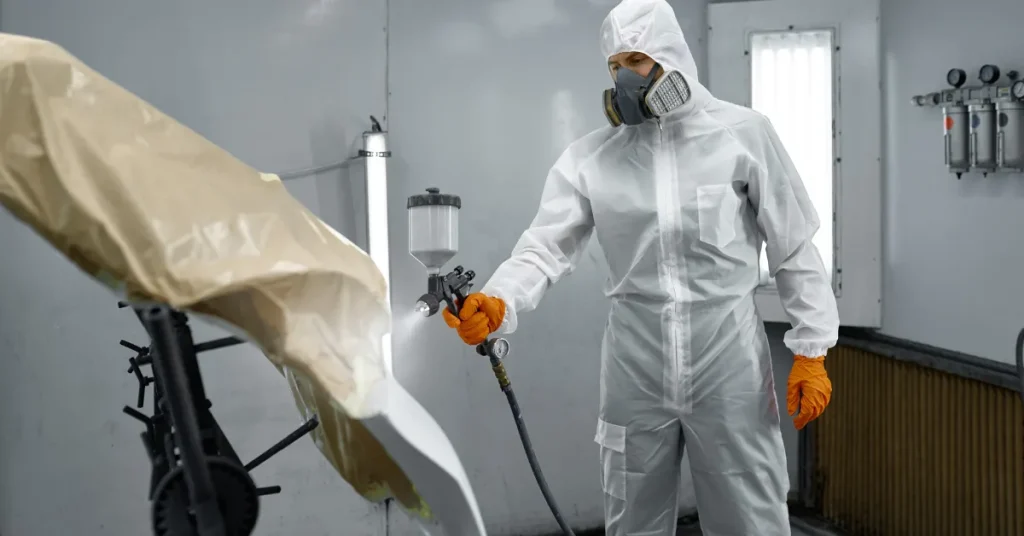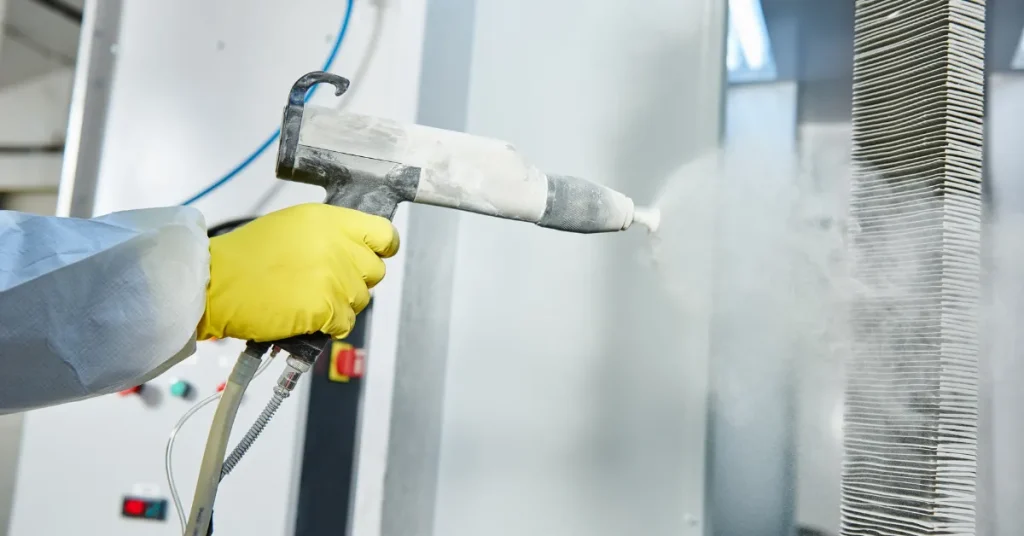A typical coat of paint is about 0.1 to 0.5 millimeters thick. The thickness can vary depending on the type of paint and application method.
Choosing the right paint for your project can be a game-changer for its final outcome. The thickness of a paint layer is crucial, as it can affect the paint’s durability, appearance, and protection ability.
This seemingly minor detail carries great importance and can be decisive in both the practical and aesthetic quality of painted surfaces.
Understanding the nuances of paint application will help you achieve the best results, whether you are freshening up a bedroom or giving a new life to an old piece of furniture.
Knowledge about paint thickness also helps in planning the quantity of paint required, ensuring a cost-effective approach without compromising on quality.
With precise application and the correct type of paint, your project will not only look splendid but will stand the test of time.

The Chemistry Behind Paint Thickness
The magic of a fresh paint job extends beyond color choice. It’s the chemistry behind paint thickness that brings durability and vibrancy to your walls.
Understanding this can help in choosing the right paint for any project. Let’s dive into this colorful chemistry.
Key Ingredients In Paint Formulation
Every paint is a complex mix of ingredients, each contributing to its thickness. Here’s a sneak peek at some key components:
- Binders: They create a film holding the paint together once it dries.
- Pigments: These give the paint its color and opacity.
- Additives: Special chemicals adjust drying time and texture.
- Solvents: They make paint liquid and evaporate as it dries.
Role Of Solvents And Pigments In Paint Volume
Solvents and pigments play a big part in paint volume. Here’s how they work:
| Solvent | Function |
| Water or Oil | Thins paint and controls thickness |
Pigments settle into micro-gaps on surfaces, adding density.
The solvent evaporates, leaving the binders and pigments behind. That’s when the paint reaches its final thickness. It’s more about what’s left on the wall than what’s applied.
Measuring The Invisible
Think about painting a wall. Have you ever wondered how thick that colorful layer is? Paint thickness might seem invisible to the naked eye.
Yet, it holds great importance. In this section, we dive into the world of paint thickness. We discover the tools and techniques to measure this unseen but crucial layer.
Tools And Techniques For Thickness Measurement
How do experts measure paint thickness? Several tools make this possible:
- Micrometer: A precise tool that measures the thickness of the paint layer.
- Wet film gauge: Measures the thickness of a freshly applied coat.
- Dry film thickness (DFT) gauge: This tool is for measuring paint after it dries.
Common techniques involve a non-invasive approach such as ultrasonic measurements. This way, the paint remains undamaged. Adherence to standards ensures accurate readings.
Understanding Mil Thickness And Its Importance
‘Mil’ is a term used to describe paint thickness. One mil equals one-thousandth of an inch. The industry standard for most home painting projects is around 1 to 2 mils for a single coat.
| Paint Job | Expected Mil Thickness |
| Single Coat | 1-2 mils |
| Double Coat | 2-4 mils |
| Industrial Coating | Up to 10 mils |
Why is mil thickness important? It determines:
- Durability: Thicker paint often means longer-lasting surfaces.
- Protection: Thick paint can better shield surfaces from wear and tear.
- Appearance: Achieve the desired look with the right mil thickness.
Knowing the mil thickness helps in making informed decisions about maintenance, cost, and quality of a paint job. It’s critical to get it right.
Factors Affecting Paint Thickness

The final thickness of a paint coat can vary greatly. Several factors play a significant role in this.
Understanding these factors will help ensure a perfect finish to your painting project. Let’s dive into the details.
Temperature And Humidity Considerations
Temperature and humidity are crucial when applying paint. Different conditions can lead to varying paint thicknesses.
- High humidity slows drying, leading to thicker coats.
- Cold temperatures can thicken paint in the can, affecting the application.
- Hot conditions make paint dry faster, potentially creating thinner layers.
It’s best to paint in recommended conditions to ensure even coat thickness.
Influences Of Application Methods
The way we apply paint affects its thickness. Here are some common methods:
| Method | Thickness Impact |
| Brush | Provides variable thickness based on bristle type and pressure. |
| Roller | Depends on nap size; a thicker nap applies a thicker coat. |
| Spray | Often results in a thinner, more even layer. |
Choose the right application method for the desired paint thickness.
Multiple Coats: A Deeper Look
When painting, one coat rarely does the trick. Let’s dive into how the number of paint layers affects the final look.
Understanding the mystery behind paint thickness can transform a paint job from amateur to professional.
Interplay Of Base Coats And Top Coats
Base coats and top coats work together. A strong foundation creates a resilient surface. Here’s how they interact:
- Base coat – Provides adhesion and evens out the surface.
- Top coat – Seals in color and adds durability.
The thickness of your paint project will depend on these layers. Typically, a base coat is thicker. Top coats add additional micrometers to the total paint thickness.
Impact Of Drying Time Between Coats
Drying time is key for a long-lasting finish. Rushing leads to a poor outcome. Here’s how proper timing helps:
- Prevents mixing of wet layers, ensuring clear colors.
- Reduces risk of peeling as each layer adheres correctly.
| Coat Type | Average Drying Time |
| Base Coat | 1-4 hours |
| Top Coat | 2-24 hours |
Always check the manufacturer’s recommendations. Some paints require longer drying times for a solid coat.
Practical Tips For Perfect Paint Application

Before diving into the vibrant world of color, understanding paint thickness matters. A typical coat of paint is quite thin, averaging around 0.1 millimeters. Perfecting paint application is not just about the color choice.
It is also about the quality of the thickness. The right tools and techniques can make a world of difference. Below we explore practical tips to achieve that smooth, even layer every time.
Choosing The Right Tools For Uniform Thickness
A painter’s toolkit is pivotal in achieving consistent paint thickness. Not all brushes and rollers are created equal. Selecting the right tool ensures a uniform coat of paint and a professional finish.
- Brushes: For edges and smaller areas, angled brushes work best.
- Rollers: Choose a roller with the right nap thickness for your wall texture.
- Sprayers: For large, even coverage, a paint sprayer can be a great investment.
Expert Techniques For A Consistent Finish
Achieving a flawless finish demands skill and know-how. Here are some expert-approved techniques:
- Prep Work: Clean and sand surfaces before painting. This ensures better paint adhesion.
- Primer Use: A primer creates a smooth base, leading to even paint application.
- Even Strokes: Use consistent pressure and direction for brush and roller strokes.
Pay special attention to the edges and corners. With these expert tips, your next paint job will boast uniformity and perfection. Remember, patience is key in painting. Let each coat dry thoroughly before applying the next. Happy painting!
FAQs About How Thick Is A Coat Of Paint
How Thick Is A Cost Of Paint?
A typical coat of paint is about 0. 1 to 0. 5 millimeters thick once dried.
How Thick Is Paint When It Dries?
Dried paint typically measures between 0. 1 to 0. 5 millimeters in thickness, depending on the type of paint and the number of coats applied.
How Thick Is A Spray Paint Coat?
A typical spray paint coat is about 0. 5 mils to 1 mil thick, equivalent to 12. 5 to 25 micrometers.
How Thick Should The Paint Be?
Ideal paint thickness is typically around 0. 003 to 0. 005 inches. Multiple thin coats achieve the best results, ensuring even coverage and optimal durability. Always refer to the manufacturer’s guidelines for specific products.
Conclusion
Determining the thickness of a paint coat is not just a matter of numbers. It’s a delicate balance that considers the paint type, application method, and the surface you’re working with.
Achieving the perfect finish requires attention to detail and understanding your materials.
Armed with this knowledge, you can tackle any painting project, ensuring a uniform and durable coat every time. Remember, a little expertise goes a long way in the world of paint application.
Resources:
1. https://highways.dot.gov/public-roads/septemberoctober-2006/are-two-coats-effective-three
